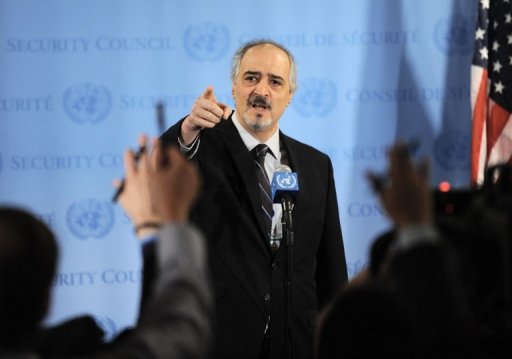Fierce clashes erupted after Syria’s regime sent reinforcements into rebel areas despite a truce pledge, as the UN said it was rushing a team to Damascus to pave the way for peace monitors.
The surge in violence on Tuesday killed at least 38 people, including 25 civilians, mostly in north and central Syria, and saw a string of arson attacks on homes, activists and monitors said.
It came a day after peace envoy Kofi Annan told the UN Security Council that President Bashar al-Assad had given assurances he would “immediately” start pulling back his forces and complete a military withdrawal from urban areas by April 10.
The United States accused Assad of failing to honor his pledged troop withdrawal, as monitors reported heavy fighting in opposition strongholds in the southern region of Daraa, the central city of Homs, northwestern Idlib province and near the capital.
The Syrian Observatory for Human Rights has charged that the army is torching and looting rebel houses across the country in a campaign that could amount to crimes against humanity.
Dozens of armored personnel carriers arrived in Dael, a town in Daraa province where the uprising against Assad began in March 2011, as well as in Zabadani, a bastion of the rebellion near the border with Lebanon.
Clashes in the Atbaa area of Daraa left three civilians and two soldiers dead, according to the Observatory.
In Idlib, heavy fighting took place on the outskirts of the town of Taftanaz, where five civilians, four rebels and seven soldiers were killed amid heavy machinegun fire and shelling, the Britain-based monitoring group said.
Clashes killed two civilians elsewhere in the province.
In central Homs, 10 civilians were killed in shelling and five others died in fighting elsewhere in the province.
With international concern at the situation growing, a draft UN Security Council statement was drawn up asking Syria to respect an April 10 deadline to halt its military operations in protest cities, according to a copy of the text seen by AFP.
The draft also urges the Syrian opposition to cease hostilities within 48 hours after Assad’s regime makes good on its pledges.
It also calls on all parties to respect a two-hour daily humanitarian pause, as called for in Annan’s plan.
Negotiations on the text — distributed by Britain, France and the United States — began on Tuesday. France’s UN envoy Gerard Araud said he hoped it would be adopted late Wednesday or on Thursday.
Russia, Assad’s veto-wielding ally in the Council, has rejected the idea of a deadline, with Foreign Minister Sergei Lavrov saying “ultimatums and artificial deadlines rarely help matters.”
Washington said on Tuesday that Assad was failing to live up to pledges for a truce.
In Geneva, a spokesman for Annan said the office of the UN-Arab League envoy expected a “UN advance team on the deployment of monitors to arrive in Syria in the next 48 hours.”
In a briefing Monday to the Security Council, Annan sought a broad mandate for the monitoring mission as he reported “no progress” on reaching a ceasefire, according to diplomats.
Syria’s UN envoy, Bashar Jaafari, confirmed the April 10 date had been agreed “by common accord” between Annan and his government.
Seeking to assuage some of the humanitarian concerns, Foreign Minister Walid Muallem pledged Syria would do its utmost to ensure the success of a Red Cross mission as he met the organization’s head, Jakob Kellenberger, who was in Damascus to seek a daily ceasefire.
International Committee of the Red Cross chief Kellenberger, on his third mission to Damascus since it launched a protest crackdown which the UN says has killed more than 9,000 people, said ahead of his latest trip that he would seek to secure a daily two-hour humanitarian ceasefire.

COMMENTS
Please let us know if you're having issues with commenting.